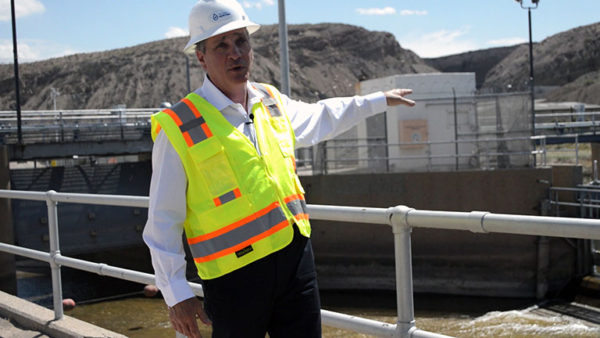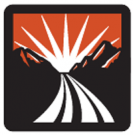There are many perils for humans and wildlife crossing the U.S.-Mexico border, from the hazards of navigating challenging terrain to the trauma of being detained by law enforcement. As tensions rise with each newly erected section of border wall, the impact of hardline policies can be seen taking a toll on the mental, physical, and environmental health of the borderland.
Rising waters threaten migrants crossing Rio Grande

Vice President of Operations and Technical Services for El Paso Water Utility Alan Schubert gestures at the intake for the American Canal in El Paso, Texas on June 3, 2019. Photo by Fred Batiste.
Risks to migrants crossing into the U.S. near El Paso have increased with the annual release of Rio Grande water from upriver in New Mexico. The release replenishes the borderlands and allows its farmers to irrigate, but the surge of water and migrants is a potentially deadly combination. Migrants who bypass barriers at U.S. ports of entry to seek asylum by crossing the Rio Grande risk drowning in the high water of the borderland canals.
El Paso Water Utility is working with a local nonprofit, the Hope Border Institute, to place posters in shelters on the Juarez side of the border to urge migrants not to try to cross the river and the canals.
Wildlife Across Borders
Erecting physical barriers along the U.S. southern border endangers the wellbeing of native wildlife in the area, says Kevin Bixby, executive director of the Southwest Environmental Center (SWEC). He is concerned that a wall’s environmental impact could lead to loss of habitat and biodiversity.
Listen: Barriers to healthy wildlife migration
The SWEC has lobbied against the wall in Washington, D.C. and organized protest rallies at the wall itself. The center is a participant in two active lawsuits against the wall.
The first lawsuit was filed March 2018 in reaction to the Department of Homeland Security’s waiver of laws — including the Endangered Species Act, Clean Air Act, and Clean Water Act — in clearing the way to build a border wall. That suit currently resides in a D.C. federal district court.
The other lawsuit was filed in February by the ACLU, Sierra Club, and the Southern Border Communities Coalition, of which the center is a part. The suit calls for a halt to construction on 57 miles of border wall in New Mexico and Arizona which was sanctioned by President Trump’s national emergency declaration earlier this year. A judge recently granted an injunction temporarily stopping construction.
When construction began last year on a new stretch of wall near the Santa Teresa port of entry, the center installed 20 cameras to bring attention to wildlife in the area. Over the course of about a year they captured images and video of mountain lions, bobcats, javelina, mule deer, coyotes, grey foxes, and badgers, among others.

A bobcat captured by one of the motion sensor cameras posted by the Southwest Environmental Center along the border. Photo courtesy Southwest Environmental Center.
“They would all be too big to pass through the wall that was built,” Bixby said.
The center is currently trying to raise $10,000 to support its staff while it continues its efforts to oppose border wall construction.
Uncaged Art Turns Lens on Trauma of Child Detainees
Among the migrant stories of hardship and life-threatening danger in the past year, one of the most controversial is that of the Tornillo tent camp where unaccompanied migrant children were detained on the eastern edge of El Paso County.
Related: ‘Uncaged Art’ exhibit gives voice to migrant children detained in Tornillo tent city
The Tornillo tent camp opened in June 2018 with room for 400 and spent the next several months adding capacity before finally shutting down in January following protests and congressional criticism. About 6,000 children passed through Tornillo during the seven months it stood.
An exhibit at the Centennial Museum at the University of Texas at El Paso titled “Uncaged Art” showcases artwork created by the children, mostly teens who were detained in Tornillo. The exhibit is a visible artifact of the mass detention of youth in the U.S. that gives visitors a sense of the conditions more than 10,000 migrant children continue to face in detention centers throughout the country.
“This is a very dangerous policy that hurts children in large numbers,” said Mark Lusk, UTEP associate dean of Health Sciences.
The Quetzal Bird of Hope
The colorful Quetzal bird is the heart of the ‘Uncaged Art’ exhibit, representing freedom for the children of Tornillo. The exhibit also includes scenes celebrating soccer, fashion, faith, and native culture.
This multimedia story was produced for 2019 Dow Jones Multimedia Training Academy by Fred Batiste, Jenna Duncan and Molly Hunter.

